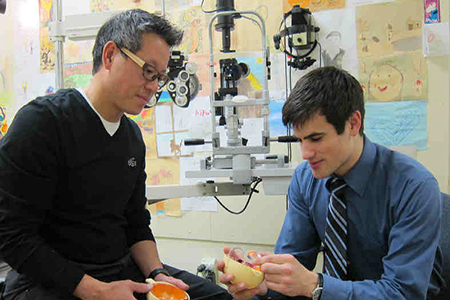Schools, businesses, products, homes and individuals are all trying to become greener or more environmentally-friendly. Students are in a great position to take advantage of all the opportunities out there — from choosing a green college or career to volunteering in your school or community. How green is your future? Read on to find out!
What Does Green Mean?
Everyone is jumping on the green bandwagon these days labeling some product event or process as green. But what does going green really mean?
It is hard to give a simple all-encompassing definition of “going green.” Each organization or company defines it a little differently. But basically it means making decisions about how you live or work based on what is best for the environment
For example you can go green by reducing the amount of stuff you use reusing what you can and recycling whatever is left. Going green in your home might mean using energy-efficient appliances or buying organic food and clothes. If your high school is going green they might be printing on recycled paper or using natural cleaning products. Companies can also go green like Levi’s which added 100 percent organic cotton jeans to its line. If you are making choices based on what is good for the world around you you are living the green lifestyle. Congratulations!
Major in Green
The Department of Labor expects the employment of environmental scientists to increase by 25 percent between 2006 and 2016 much faster than the average for all occupations. Colleges and universities are recognizing the growth in environmental fields and are creating new courses and programs. If you have a real interest in working in an environmental profession now is definitely a great time to begin your studies or career.
Choose environmental studies and you will be studying how humans interact with nature. Choose environmental science and you will focus more on the physical chemical and biological aspects of environmental issues. These common options are available at a variety of schools including Iowa State University the University of San Francisco Saint Joseph’s University (PA) Dickinson College and Washington State University which recently created its school of earth and environmental sciences.
Many schools also blend traditional fields of study with a focus on the environment. For example Arizona State University combines sustainability with urban studies in the nation’s first school of sustainability (accepting its first undergrads in fall ’08). You can take courses in sustainable cities urban growth or urban ecological systems and receive undergraduate and graduate degrees in sustainability. Even some non-environmental courses are participating in the green movement like Saint Joseph’s marketing classes in which students develop marketing plans for the school’s recycling program.
Would you consider a career in environmental engineering environmental law environmental communication or even environmental crime? You can find environmental jobs in almost any area these days. Whatever you’re good at — teaching analyzing studying growing plants brainstorming writing digging working with animals computing building persuading — you can work toward a career that uses those skills for the environment.
Green Colleges and Universities
Just as colleges are adding courses and majors it seems like every school has green projects underway. Iowa State is building a green addition to their college of design. They are also recycling furniture throughout living communities and trying to use materials that are more environmentally-friendly according to Maura Flaschner, interim associate director freshman admissions.
Saint Joseph’s “greatly enhanced our recycling program adding something like $250000 to our budget in 2007,” says Michael McCann, professor of biology and associate dean of the College of Arts and Sciences. He also describes other changes at the college including the addition of rainwater collection systems in parking areas and energy-saving renovations around campus.
The University of San Francisco is “recognized for our environmental efforts — out of the classroom (recycling solar energy) and in the classroom,” says Mike Hughes, director of admissions. At Dickinson students started a garden several years ago and the Dickinson College Farm was born. Today it grows and sells produce to the college and to farmers’ markets and donates to the local food bank.
Sustainability means living our lives in a way that will have minimal long-term effects on the environment and future generations and many schools are making specific efforts to become more sustainable. For example the University of California San Diego is taking steps to become the leading user of renewable energy among U.S. schools. They expect to generate 10-15 percent of their energy needs through solar panels wind farms and renewable methane within the next few years.
“Campuses are adding sustainability coordinators to their administrative staff to work alongside students and administrators in determining the most effective ways to reduce their carbon footprints,” says Stephanie Balmer, Dean of Admissions and Financial Aid at Dickinson.
If you’re interested in how successful large colleges and universities are at being green check out the College Sustainability Report Card. It grades schools with the 200 largest endowments (mostly donated money) on how they are using those funds to become more sustainable. More than two out of three schools improved their sustainability grade three in five schools have green building projects underway and 70 percent of these colleges devote at least a portion of their food budget to buying from local farmers and/or producers according to the report card.
Colleges are offering all kinds of volunteer opportunities as well. Washington State regularly schedules group projects that get students involved in sustainable practices. Students can participate in projects to beautify and improve the school and community during Cougar Pride Days or they can combine recreation (canoeing) with environmental action (shoreline cleanup) on an Eco Adventure. If you would like to get paid for your efforts Saint Joseph’s offers work-study positions with the recycling staff to collect materials from campus.
If your future college’s environmental position and activities are important to you check out its website to find out what it’s doing to become a green school of the future. Also visit the Presidents Climate Commitment where hundreds of university presidents across the country have already signed an agreement to address global warming.
Green Colleges and Universities
You’ve probably heard the words “You can make a difference!” But are you one of those students who needs a little proof? Chad Pregracke worked summers on the Mississippi River during high school and college and noticed that more and more trash was accumulating on the shores. He decided to do something about it so he founded Living Lands & Waters an organization that cleans up the Mississippi and other rivers. His story appeared on television and in national magazines and he won numerous awards including Biography magazine’s “Top Ten Classics in America.”
Need a few more examples? How about a bunch of Dartmouth students who decided to take a road trip a few years ago in an old school bus that ran on vegetable oil? The trip turned into an organization called The Big Green Bus which travels around each summer educating people about climate change and alternative energy.
Or consider two of the 2007 President’s Environmental Award winners Michael Browne and Bianca Locke. Michael an Eagle Scout from Massachusetts started a campaign to remove lead from fishing tackle. And after teaching younger children about ways they could help the environment Bianca a senior from Texas decided to develop her own curriculum. She wrote two books and created activities that have been presented to a wide variety of audiences including the Boy Scouts NASA employees and science teachers. Maybe you don’t feel that you are ready to devote your life to a big organization right now. Still there is plenty you can do! Does your high school have an environmental club? If not start one! Get a recycling program going in your school or community. Volunteer at your local pet shelter. Adopt a piece of highway or riverbank with a club or group. Carry reusable shopping bags take shorter showers and ride a bike more often. Use your own container for water instead of buying bottled. Check out Envirothon — the largest North American environmental education competition.
There is so much to do — it is just a matter of finding the right thing for you. If you need some help check out the “Do Something” organization. The site offers lists of causes you might want to get behind reasons to volunteer and even virtual volunteering. You can also plug in your zip code and find all kinds of opportunities in your area.
Green is Here to Stay
More than just a trend green living is everywhere — from the new building going up on campus to the milk you pour on your cereal from your possible future career to the product you use to wash your socks from the organization of your trash to the way you will fill up your future car (if there is a car in your future!).
It seems like everyone and everything is going green these days — how about you? Try on a little green and take a look in the mirror. You just might like what you see!



